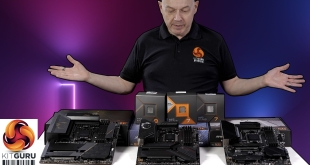Asus have adhered to their popular colour scheme with the F1A75-M Pro which consists of a black PCB with blue accenting. This gives the board an attractive appearance and should make it easy to colour co-ordinate your system. Asus have opted for a Micro-ATX form factor which makes the F1A75-M Pro a very versatile product as it can be used in everything from HTPC's to desktop tower builds.
As it's name suggests, the F1A75-M Pro features the A75M Fusion Controller Hub which is the more feature rich model. This includes six SATA3.0 (6 GB/s) ports with RAID support and four USB3.0 ports. Unlike previous AMD platforms, there isn't an integrated GPU on the motherboard as it is packaged into the CPU.
There are four expansion slots located on the board, consisting of two PCI Express x16 slots, a single PCI Express x1 slot and a legacy PCI slot. We can't imagine that many people will install two graphics cards onto this motherboard but we appreciate the inclusion of a second PCI Express x16 slot as the PCI Express x1 slot may well be blocked by dual bay graphics cards. This means there is room to add a dual slot graphics card in conjunction with a dedicated sound card and a TV tuner, should you want to use this board within an HTPC.
Even though the Lynx platform requires a slightly different CPU socket from previous AMD products, the cooler mountings are the same, meaning you can use any existing AM2+/AM3 cooler. AMD have changed the design of the mounting slightly, so it is identical to the latest AM3+ platform.
There is a small heatsink covering a portion of the power regulation circuitry for the APU. The rest is left bare, though, as Micro ATX boards aren't usually used for serious overclocking. Along the top edge of the motherboard there is an 8-pin power connector for the APU.
The Asus F1A75-M Pro supports up to four DDR3 DIMMs, running at a maximum speed of 1866 MHz. We found that our RAM was clocked down to 1333 MHz by default, though, and had to set it at the correct speed in the BIOS.
In the bottom right hand corner of the motherboard we find the six SATA3.0 connectors which are angled at 90 degrees to the motherboard to facilitate cable management. Next to these we find the front panel connectors alongside four USB 2.0 front panel headers, a USB 3.0 front panel header and the HD Audio header.
We find a reasonable selection of I/O connections on the back panel which should suffice for the majority of people. From left to right there is a PS2 connector, two USB 3.0 ports, a digital optical audio jack, HDMI, VGA and DVI connectors, two further USB 3.0 connectors, an RJ-45 ethernet jack, two USB 2.0 ports and six 3.5mm audio connections. The only notable omissions are Firewire and eSATA which seem to be less important these days now USB 3.0 is gaining traction.
 KitGuru KitGuru.net – Tech News | Hardware News | Hardware Reviews | IOS | Mobile | Gaming | Graphics Cards
KitGuru KitGuru.net – Tech News | Hardware News | Hardware Reviews | IOS | Mobile | Gaming | Graphics Cards










